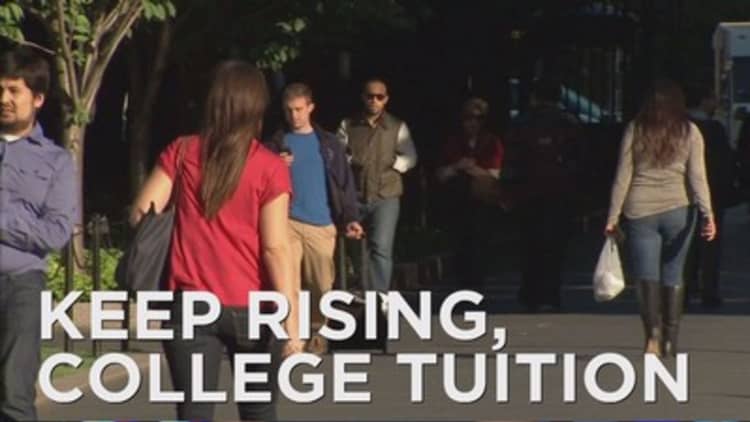Investors aren't keen on surprises, especially when they're getting out their checkbooks to write a series of very large checks for their children's college education.
When you're in the midst of choosing bedding and organizers with your child for their college dorm, it's not the time to find out that your 529 college savings account has plummeted by 20 or 30 percent.
Unless you're careful, risks could be lurking in your 529, say financial advisors. Many families experienced drops like this in the 2008 and 2009 period, just as they needed to pay for college, because they were not carefully monitoring the asset allocation of their accounts.
Read MoreWhy you should major in math, science
"People take for granted that the asset-allocation changes will be appropriate to their risk posture," said Andrea Feirstein, founder of AKF Consulting Group, an advisor to 529 plan administrators in 32 states.
College savings plans come in three varieties: age-based funds, static asset-allocation funds and a free choice of funds.
Look under the hood
Age-based funds move along a glide path as children grow and near college age. These funds start with big allocations of equities and gradually taper their stock exposure.
Most start out with a high allocation toward stocks, 80 percent on average, though some invest completely in stocks for the first few years. About two-thirds of self-directed 529 assets are housed in age-based funds, according to research firm Strategic Insights.
Read MoreHottest jobs for college grads
Static asset-allocation funds ask investors to choose one risk profile—conservative, moderate or aggressive—and then invest the money in the appropriate mix of stocks and bonds, never veering from the allocation as children age.
Finally, 529 accounts can also be invested in individual funds, provided the particular program allows for it.

"One of the things people discovered in '08 and '09 was that even when their kid was 17 years old, their account had a 40 percent exposure to equities," said Feirstein at AKF Consulting.
Investment advisors to the 529s have since tamped down on their equity exposure in the years before college. "Most the plans remodeled their asset allocation to stocks so that it's somewhere between 0 and 20 percent in those last years," Feirstein noted.
On average, the funds invest 14 percent of their assets in stocks for students who are age 18 and just 11 percent at age 19, according to Morningstar. However, there is a wide range among plans.
"There is no industry standard for the glide path," said Paul Curley, Strategic Insights' director of college savings research.
Not all glide paths are alike
Some funds use a progressive glide path, much like a target-date fund. They reduce a small percentage of their stock exposures each year. More common in 529s is to use fixed tracks, reducing bigger allocations of stocks at set points in time.
For example, in Kansas's Learn Quest 529 program's aggressive fund managed by American Century Investments, the stock allocation drops from 90 percent to 70 percent at age 7. At age 18, the allocation goes from 50 percent in stocks to none.
Read MoreHow to refinance that student loan
"That could lead to a permanent loss of capital if the markets plunged shortly before the beneficiary's 18th birthday," wrote the analysts in Morningstar's recent "529 College-Savings Plan Landscape" report.
This is particularly worrisome now, said Deborah Fox, president of Fox College Funding, given the strong investment returns of recent years. "Anytime we're in the latter half of a bull market, investors need to be careful and have a Plan B if things don't go as planned," she said.
Fox urges clients to resist tapping a 529 plan that's dropped in value if they have money elsewhere, for fear of locking in losses. Since the account can be used for graduate school or other family members, there's no rush to deplete it.
"Families are not saving enough, and some may be leaning on that little extra risk as one way to catch up," said Strategic Insights' Curley.
Be careful with bonds, too
At the same time, funds that go heavily into bonds in an attempt to shield assets from sudden drops in the later stages of college savings should also be monitored.
Given the expectations for higher interest rates, which could batter bond funds, Fox at Fox College Funding prefers cash when moving money into so-called safer options.
Read MoreUnderstanding target-date funds
"When you look at where short-term bond fund yields are, there's not much of a difference between that and cash," Fox said. "I'd rather have the insurance policy of cash."
Further, noted AKF Consulting Group's Feirstein, "a bond fund is not riskless."
In 2008, for example, investors in Oregon's 529 plan were blindsided by severe losses in one of the plan's holdings, the Oppenheimer Core Bond fund, which lost nearly 36 percent that year. The state of Oregon sued the fund company the following year.
It may still be appropriate to have some exposure to equities even when your child is nearing college. Your money still has to last.Andrea Feirsteinfounder of AKF Consulting Group
Still needing stocks
Like the advice for investing in retirement, many observers say that equities might still have a place even in the later stages—just be sure you have enough safe, liquid assets to pay for immediate college needs.
"It may still be appropriate to have some exposure to equities even when your child is nearing college," Feirstein said. "Your money still has to last."
But when money is needed in the next year or two, certified financial planner Christine D. Moriarty, president of MoneyPeace, recommends moving it into an instrument that's insured by the Federal Depository Insurance Corp. for peace of mind. Twelve states offer such options, usually as savings accounts or certificates of deposit.
—By Ilana Polyak, special to CNBC.com




